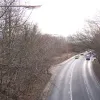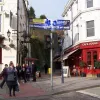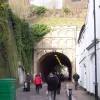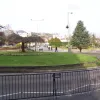You might not have been to Reigate. I certainly hadn't, but that changed when I heard that it was home to a quite extraordinary piece of road history. Reigate, the small Surrey town between London and Gatwick Airport, is home to the world's first road tunnel.
It was paid for and built by Earl Sommers, who lived in the splendid house on a hilltop by the town centre. His estate stood between the town and the road north to London, meaning traffic had to divert around the outside. He built a tunnel through his grounds, so his estate remained peaceful and the locals could get directly to the London road. It opened in 1823, and until 1856 a toll was levied, from ½d for a horse up to 6d for a coach and four. Pedestrians could use it free.
The narrow brick tunnel remained in use as part of the A217 until the early 1970s, when it was closed to traffic and replaced with a one-way system around the hill — back, in fact, to the way traffic had gone before the tunnel was built. You can see the change in the Ordnance Survey map extracts below, one from 1970 and the other from 1973.

If you're not familiar with Surrey, you'd be forgiven for thinking it's quite flat. The south is quite flat, isn't it? Not quite — we're in the North Downs here, and to the north of the town, the A217 Reigate Hill descends some 110m (360ft) between the M25 and the town centre.
Here's the road itself, weaving slightly to find an easy path down the hill and offering some Alpine views to the south. The bridge from which this picture is taken replaces a small suspension bridge built by William Constable, the man who also built the tunnel we're about to see.
Looking north on the A217 in the town centre, a smaller hill rises in the middle of the built-up area, just behind the buildings ahead. This was the site of Reigate's castle, now long gone — the grounds of which stopped the London road from getting through.
Where northbound A217 traffic turns left onto the one-way system, there's a gap in the shops — little more than an alleyway between a restaurant and a pub.
Pass between the shops and the tunnel itself is immediately visible just a few paces further on. It's still not much more than a wide path, but until about 1972 you could drive through here.
It seems to be less used than it used to be; buildings like the one on the right seem to be closed-up, and inside the tunnel, there's boarded-up openings to man-made caves where sand was extracted and the resulting space used to store beers and spirits.
Above the southern portal is this plaque, reading "This private road was formed through the private grounds of the Right Honourable John Sommers Earl Sommers in the year M.DCCC.XXIII.
Looking towards the south again, from just outside the northern portal, it's clear the tunnel is sloping downwards still as it heads towards the town centre.
The north side of the tunnel is not built up, and the approach road runs in a cutting which has been taken through rock. The walls are sheer faces of bare rock — now etched with hundreds of messages from Reigate's youth over the years, announcing who currently loves who.
At the northern end the A217 used to negotiate a roundabout — and it's still there, now part of a larger traffic island. Beyond it the road continues towards Reigate Hill and London.
Up above, the Earl's grounds are now a public park, with this fine house standing in the middle of open lawns.
There's also this folly, forming another tunnel, on which is mounted a plaque declaring that it is "to save the memory of William Earl Warren who in old days dwelt here, and was a loyal champion of our liberties from perishing like his own castle by the ravages of time, Richard Barnes at his own expense erected this gateway in the year 1777".
With thanks to Ian for information on this page.















